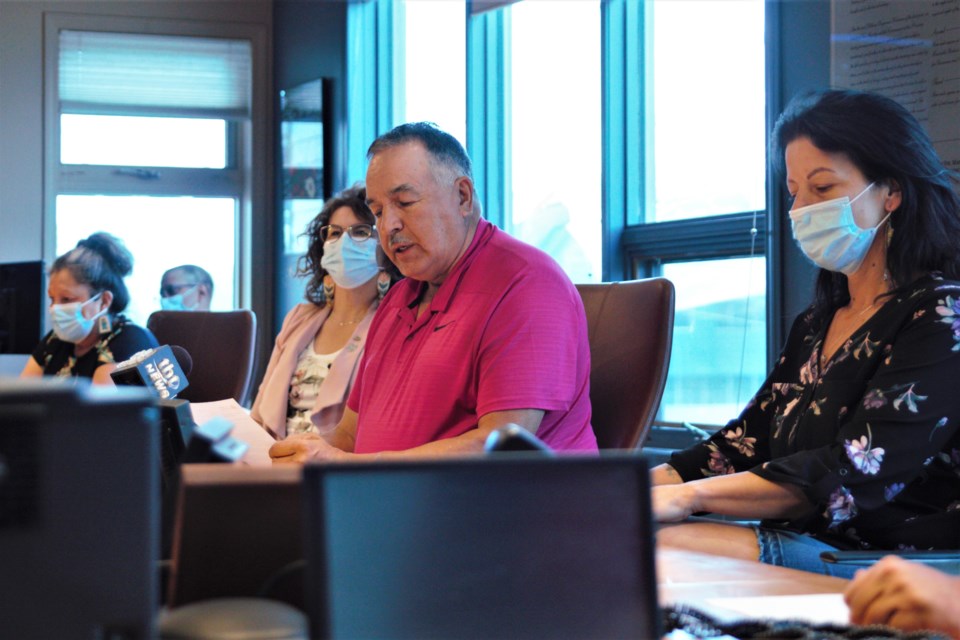FORT WILLIAM FIRST NATION – Fort William First Nation is calling for assistance in launching a full investigation of three sites on its traditional territory leaders believe could contain undocumented burial grounds.
Chief Peter Collins, flanked by members of council, outlined the community’s demands for support and cooperation from governments and the Catholic Church Friday morning at the First Nation’s band office.
“In the wake of the ongoing discovery of mass burial grounds linked to Indian Residential Schools, [we] are calling for a swift and actionable response from the federal government, to use all means necessary to respectfully identify and return the remains of the children to their communities,” he said.
“We’re not asking – we’re demanding that this government do the right thing in looking at these particular sites that we’ve identified here today.”
The three sites include the former St. Joseph’s Indian Residential School, the shuttered Lakehead Psychiatric Hospital, and a grave site on the First Nation’s original reserve site, from which members were forcibly relocated in 1905.
All three sites are located within what is now the city of Thunder Bay.
The call comes weeks after the Tk'emlúps te Secwépemc revealed the discovery of an unmarked burial site containing the bodies of 215 children using ground-penetrating radar at the former Kamloops Indian Residential School.
Collins said council’s decision to move forward promptly with investigations was informed by discussions with elders in the wake of that discovery, when the First Nation also lit a sacred fire at the former St. Joseph’s school site.
“We see the impacts on our families here,” he said. “People thought their kids or loved ones just ran away and disappeared. We don’t know what could be there or what could have happened to them.”
“Our council made the strong decision that this is what we want and what we need.”
St. Joseph’s, now the site of the Pope John Paul II elementary school, was affiliated with the Roman Catholic Church and operated from 1870 to 1966, first as a girls orphanage, and later also as an Indian Residential School.
Collins said there were plenty of stories about the school from First Nations across the region, but those had yet to be comprehensively collected.
“I think it’s important we get the feedback of our members who were at that site, about what they dealt with in that facility,” he said.
The 2015 final report of the Truth and Reconciliation Commission identified 3,200 deaths of residential school students across the country, but concluded many others went unrecorded, or records were later destroyed.
In 2009, the federal government declined the TRC’s request for more funding to investigate the question of student deaths at residential schools.
Fort William First Nation has limited documentary evidence about the three sites, Collins noted, and is calling on governments and the church to cooperate by releasing any requested documents, and ensuring no more are destroyed.
“Our community doesn’t know a lot about what records exist, how many of our members are maybe at any of those sites,” he said. “That’s the challenging part for us, that information is important to us so that we can do proper work.”
For example, he said little is known about how thoroughly a community grave site was exhumed when Fort William First Nation was forcibly relocated by the federal government in 1905, to make way for a grain terminus for the Grand Trunk Pacific railway.
“When they forced us off of that land, they said they exhumed all of the bodies,” he said. “We don’t know if they got them all, so we are asking for this government to… make sure each and every one of those family members are [brought back to] their rightful place in Fort William.”
At the Lakehead Psychiatric Hospital, Collins said, “we know they experimented with our kids. We want that site sounded out.”
Support from the City of Thunder Bay will be crucial, he said, with the sites within its boundaries.
“We’ll need to make sure we’re doing things respectfully and together with [the city] so we’re not having an impact on some of those sites,” Collins said Friday.
Neither the federal nor provincial governments had yet reached out directly, though both have stated they will offer support to Indigenous-led investigations.
“I think it’s their responsibility, [and] I think the Church has responsibility in this [too],” said Collins.
“Who’s going to take the responsibility for those young people that they found in Kamloops? Who’s going to be held accountable if we find lost loved ones on the St. Joseph’s site? I think the government needs to take a good hard look at that.”
Perhaps most importantly, the community needs to know the truth about the extent of colonial violence in Canada, Collins said. Residential schools were just one part of an explicit project to destroy Indigenous cultures, he emphasized.
“The important part is teaching future generations about the traumas of Indian Residential Schools, how it impacted our community, and it still impacts our community today,” he said. “We see it on an ongoing basis here in our community.”
Councillor Michele Solomon encouraged community members to do their own part to fully understand Canada’s colonial history and how to move forward by familiarizing themselves with the final report and calls to action of the Truth and Reconciliation Commission, which she said set out a roadmap for healing.
For former students and others impacted, a National Indian Residential School Crisis Line is available 24 hours a day at 1-866-925-4419.
